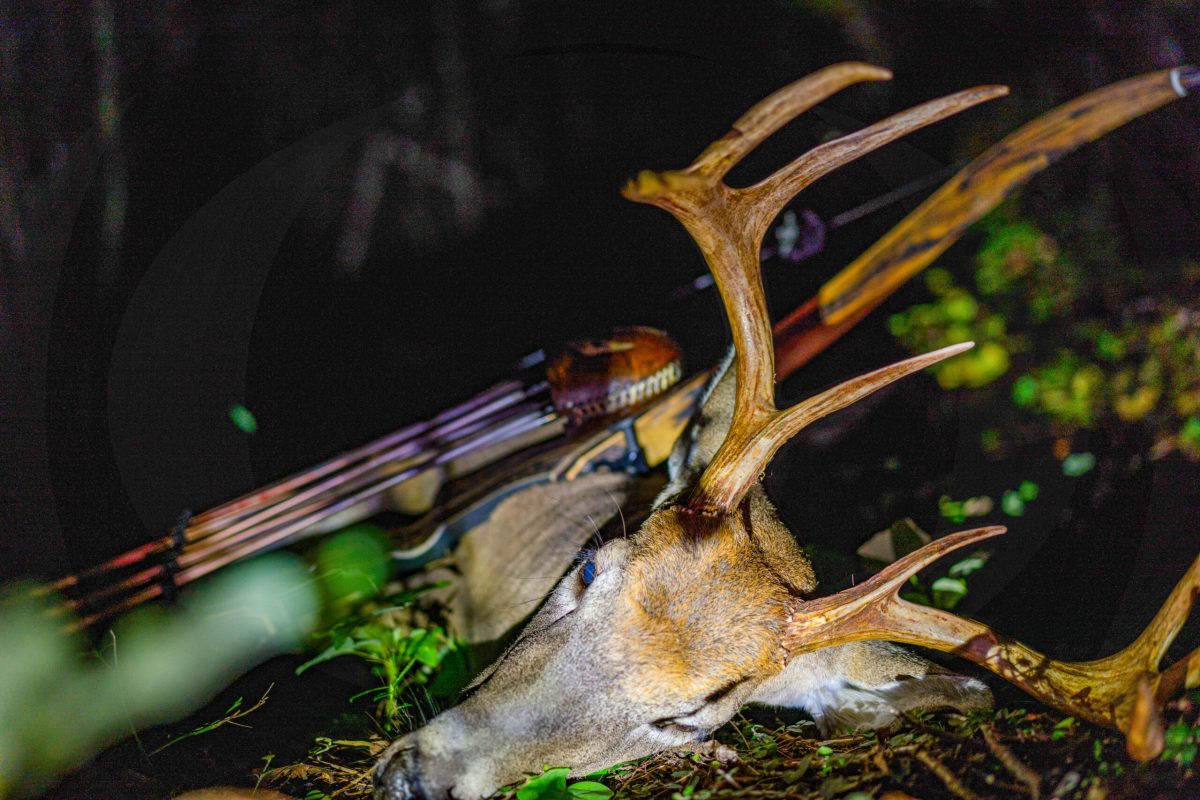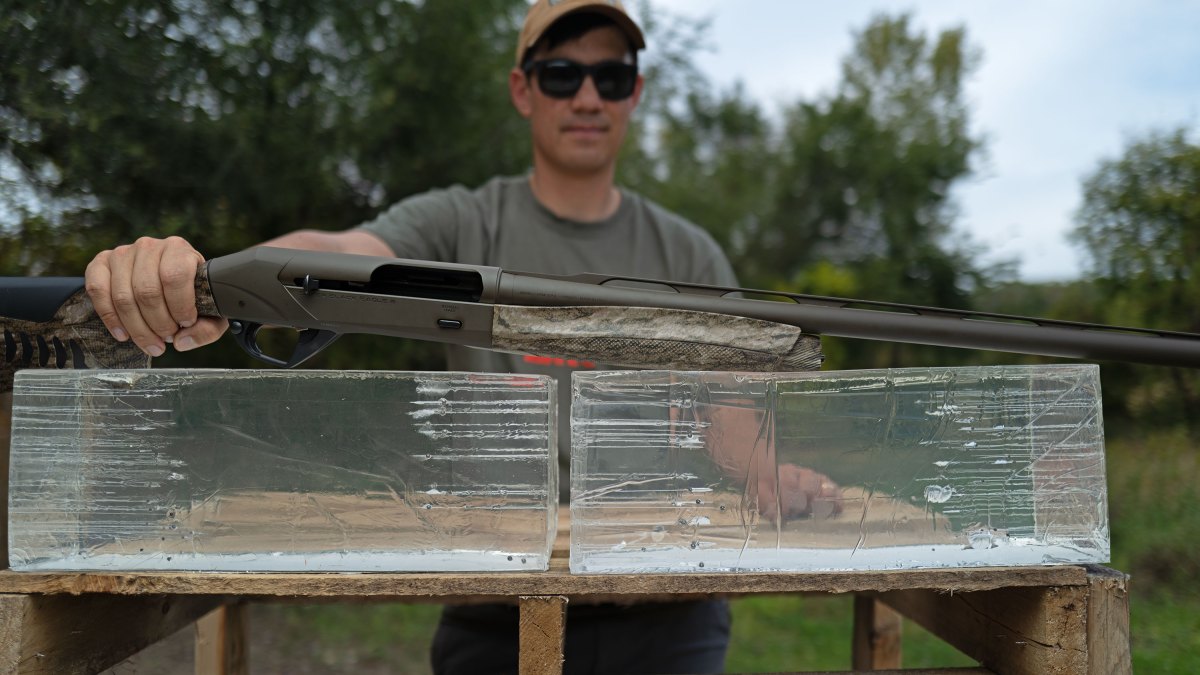12 Best Binoculars, Our 2025 Optics Test Winners

This year’s collection of binoculars in our optics test is all over the place. We have a pair of compact binos, some stabilized units, a handful of large-frame binoculars, and probably the smallest assemblage of conventional 10×42 units in the history of our test.
In most years, we have so many submissions in each of the sub-categories of compact, mid-sized, and large-frame binoculars that we break them into groups of peers. Not this year. We threw all the binos in one big collection and worked through them, moving from an 8×32 Tract to a 15×56 Burris, and from an image-stabilized Sig to a $150 Bushnell 10×42.
We did try to pair up similar configurations with each other. For instance, we had three 12×50 units, from Zeiss, Leupold, and Bushnell, and while they are all at vastly different price points, they served as useful peer-to-peer comparisons.
We always try to tease out trends in our tests, and the rise of super-sized binoculars seems here to stay. We had only four binos with objective lenses of 42mm or smaller this year. That left nine other binoculars with objective lenses sized 50mm or larger.
Stabilized binoculars are also having a moment. This year we had three units, from Sig Sauer, Kite, and Nikon, and several brands are working to bring stabilized optics to the market next year.
We struggled with a Great Buy in this year’s binocular category, but ultimately felt that the two compact models in the test represent a ton of value for a fairly steep price point, considering this is our budget award. We gave two Great Buy nods, one to the conventional Tract Toric 8×32 for its wide versatility and fine handling. And we gave a Great Buy to the very unconventional Nikon Stabilized 12×25 for its ground-breaking design and ability to deliver 12-power magnification in a vibration-free unit that fits in your jacket pocket.
Best New Binoculars of 2025
Large-Frame Binoculars
Image-Stabilized Binoculars
Mid-Size Binoculars
Great Binoculars from Past Tests
Jump to the testing protocol
Best New Binoculars of 2025
Editor’s Choice: Zeiss SFL 10×50
Buy From Midway USA
Buy From EuroOptic
Pros
- 10×50 performance in 10×42 frame
- SmartFocus fast-turning focus wheel
- Light for configuration
Cons
- At nearly $1,800, expensive
- Requires larger bino harness pouch
Key Features
-
Open-barrel, dual-hinge design -
Right-barrel diopter -
Oversized focus wheel -
¼-20 tripod adapter -
Magnesium housing -
Lifetime transferable warranty
A year after Zeiss introduced its SFL binocular in 8×40 and 10×40 versions, the German brand has achieved a pinnacle accomplishment with 10×50 and 12×50 models in the line, delivering 50mm performance in a 42mm-sized chassis.
The result is a powerful, bright, and extremely well-balanced binocular that is optimized for hunters and birders who value walk-about size and weight but want a little more optical horsepower than a standard 10×42.
The combination of excellent glass, a responsive and tactile focus wheel, excellent ergonomics, and what we consider a fair price for a premium optic earned the Zeiss SFL our consensus pick for Editor’s Choice as the top binocular of 2025. While the award goes to the 10×50 SFL, Zeiss’s 12×50 SFL accrued nearly the same score.
Both binoculars achieve their compact frame and relatively light weight through a redesigned optical prescription that uses thinner, lighter lenses stacked relatively close together in the magnesium chassis. The result is a 6.3-inch binocular that weighs just under 31 ounces. Those dimensions are standard for 10×42 binoculars, but the Zeiss models give users 18 percent more magnification (in the 12x version) and a significantly larger exit pupil in both versions, delivering more light to users’ eyes and contributing to overall image brightness compared to 10×42 binoculars. The 50mm objective lens, with 42 percent more surface area than a 42mm, is similarly capable of delivering significantly more light to the eye.
Manufactured in Japan, the Zeiss’s glass is excellent, with no observed edge distortion or flaring, and testers noted the vivid color rendition and remarkable image brightness.
“A do-it-all, take-it-anywhere piece of gear for hunters, wildlife watchers, spectators, etc.,” noted tester Luke Coccoli.
And tester Ky Idler, who noted some stickiness in one eye cup and some tooling marks in the interior of one barrel, said “The glass is clear. I would not be afraid to glass with this for hours. Zeiss nailed it.”
The open-barrel build and light weight enables one-hand operation, and the balance is excellent, settling in both hands without feeling forward heavy. The fast-focus wheel is especially useful, even under gloved fingers. In fact the SFL naming convention comes from Zeiss’s term for this control: the very Germanic SmartFocus Concept. The oversized focus wheel turns from close focus of 6 feet to infinity in just 1.4 turns of the wheel.
The rest of the unit has the features you’d expect: a good tripod mount on the front hinge, right-barrel diopter control, and three-position eyecups. The SFL is covered by a transferable warranty.
Of the two units we tested, I prefer the 10×50. The wider field of view makes images seem more panoramic, and the 12×50 version has just a little hand-shake unless I lock my elbows in. But for users who stabilize their binos on a tripod or other support, the 12×50 offers just a little bit more reach with the same vibrant, bright image.
With the addition of the 50mm models, Zeiss’s SFL line now includes an 8×30, 10×30, 8×40, 10×40, 8×50, 10×50, and 12×50.
The 10×50 and 12×50 SFL models retail for $1,799 and $1,999, respectively. It’s an investment, for sure, but we think between the optical performance, ergonomics, and disruptive design, the Zeiss SFL is an heirloom-grade binocular that will produce years of satisfying viewing.
| Zeiss SFL 10×50 Specs | |
| Magnification: | 10-power |
| Objective Lens: | 50mm |
| Light Transmission: | 90 percent |
| Exit Pupil Diameter: | 5.0mm |
| Twilight Factor: | 22.4 |
| Field of View: | 366 feet at 1,000 yards |
| Close Focus: | 5.9 feet |
| Weight: | 30.8 ounces |
| Length: | 6.3 inches |
Great Buy (Traditional Bino): Tract Toric UHD 8×32
Buy it From Amazon
Buy From Tract
Pros
- Tight and durable build
- Bright Schott high-transmission glass
- Light at 23 ounces
- Easy one-hand operation
- Tight and positive controls
- Lifetime warranty
Cons
- Relatively expensive for a compact bino
- Slight blue edge aberration
Key Features
-
Closed-bridge design Locking right-barrel diopter -
Front-hinge ¼-20 tripod thread -
Magnesium-alloy chassis -
3-position eyecups -
Easy one-hand operation
Calm down, settlers. I hear your roars of discontent that we have named a $644 compact binocular an Outdoor Life Great Buy. That’s a lot of money for relatively little glass. But hear me out. First, there wasn’t a lot of competition for the award this year. There were cheaper submissions, but they were optically inferior to this bright, tight little unit. And this binocular from a direct-to-consumer company punches way above its size. Add the lifetime warranty and versatility from whitetail stands to turkey vests to every truck console in America, and this is the binocular you will reach for above all others.
We’ve tested the big brothers of the 8×32 in previous tests, but this configuration hits a sweet spot. Its image seems like it was delivered by a big 10×42, but the small frame of the 8×32 fits in places the larger chassis doesn’t.
Then there’s the tight build of the Toric. Those who have followed the evolution of Tract Optics know one of its distinctive features is smooth, positive, extremely tactile controls. Scope turrets move with smooth precision and binocular eyecups feel like they glide on ball-bearing races. Those controls extend to the focus wheel, locking diopter control, and eyecups of this smallish binocular.
The detail that cemented the Great Buy award for the Tract Toric is its lifetime warranty. I doubt you’d ever use that coverage, but it’s useful to know that you have a binocular for life. In the field, you’ll use it for a one-handed spot-and-stalk bowhunting optic. You’ll have it in your bino pouch for turkey hunting or hiking. Or you’ll throw it in your luggage for a travel optic.
Testers subtracted points for a fairly clunky build and some blue color fringing. Testers who gravitate toward full-sized 10×42 binos thought the compact Tract was underwhelming.
“My first impression was that I didn’t want to like this binocular,” noted tester Ky Idler. “But surprisingly it fit my hands. Good glass. It would be a very good spot-and-stalk binocular.”
The Tract seems bigger than it is largely because of its excellent glass. It’s built around high-transmission Schott glass, manufactured in Japan, and has a wide field of view. Normally, I like open-barrel designs for one-hand operation, but the closed-bridge build of the Toric, while a little center-weighted, has enough heft that it settles in hand, whether one hand or two.
I’d readily use this binocular for bowhunting, when single-hand operation is required and where positive focus control helps parse close, medium, and far range targets. The Tract capably handles this chore with aplomb, if not distinctive style.
Maybe this helps answer the question: Is $644 too much to pay for a quality compact binocular? In the case of the Tract Toric UHD, the answer is decidedly no. While I’m not eager to pay more, this is a solid deal for a very good and versatile hunting optic.
| Tract Toric UHD 8×32 Specs | |
| Magnification: | 8-power |
| Objective Lens: | 32mm |
| Light Transmission: | Not provided |
| Exit Pupil Diameter: | 4.0mm |
| Twilight Factor: | 16 |
| Field of View: | 424 feet at 1,000 yards |
| Close Focus: | 6.5 feet |
| Weight: | 23 ounces |
| Length: | 5.2 inches |
Great Buy (Stabilized Bino): Nikon Stabilized 12×25
See It
Pros
- High-power binocular in compact frame
- Stabilization powered by twin AA batteries
- Traditional binocular form factor
- Light weight, at 13.9 ounces
- 12 hours of battery life
- Auto power shut-off
Cons
- At $649, pretty pricey for a compact bino
- Fragile
Key Features
-
Uses widely available AA batteries -
Compact stabilization module -
Stabilization enables vibration-free hand-holding -
At 3.9 inches long, super compact
In order to appreciate the audacious capabilities of this tiny, super-hero binocular, it’s helpful to understand how image-stabilization works.
Most image-stabilized binoculars have a single gyroscope that tames environmental vibrations, whether delivered by shaky hands or by straight-line winds. This usually bulky central control center helps understand why Sig’s stabilized binoculars don’t have traditional twin barrels. Instead, they have undifferentiated barrels that are controlled by a single prism at the head of the works, between the focus wheel and the eyecups.
But Nikon has disrupted the norm by delivering a stabilized binocular that actually looks like a binocular. They do this by installing image-stabilizing modules in each barrel. The upshot is that Nikon has delivered a high-magnification binocular (12-power) in a super-compact frame that’s easy to hold in a single hand. It’s honestly a form of optical magic.
The result is that you can fit this tiny binocular in a jacket pocket or the front pouch of a backpack and deploy it on a birding trip, a European vacation, or any bowhunting adventure.
I have to acknowledge a rare failure in our optics test, but it’s instructive for readers who are in the market for a stabilized binocular. We dropped this Nikon Stabilized bino during our optics test. It fell off a tripod directly on a concrete pad and the impact knocked it out of collimation. I mention this because I’ve been concerned about the durability of the design of Sig’s stabilized ZULU6 line of optics, but in our experience – with a super small sample size – this two-barrel design may be less durable than the single-barrel design of Sig and Kite.
But even with that durability demerit, the Nikon charmed us with its optical horsepower in a hand-sized frame. It goes everywhere. It does almost everything. And, at about $650, it’s a steep but fair price for such a versatile optic.
Add to the positives the fact that the stabilization module takes widely available AA batteries, delivers a decent image, and provides awesome magnification in a hand-sized unit. It’s a great travel and sports-spectating optic, but it has abundant talents for close- to mid-range targets that most bowhunters and turkey hunters encounter.
| Nikon Stabilized 12×26 Specs | |
| Magnification: | 12-power |
| Objective Lens: | 26mm |
| Light Transmission: | Not provided |
| Exit Pupil Diameter: | 2.1mm |
| Twilight Factor: | 17.7 |
| Field of View: | 236 feet at 1,000 yards |
| Close Focus: | 9.8 feet |
| Weight: | 13.9 ounces (without batteries) |
| Length: | 3.9 inches |
Best Large-Frame Binoculars
Zeiss Conquest HDX 15×56 LRP
Buy it From Amazon
Buy It From Midway USA
Pros
- Excellent range spotter
- T-style MIL-based reticle in left barrel
- Reticle leveling feature
- Ships with excellent tripod mount
- Dual diopter adjustments
- Reticle can focus out of image plane
Cons
- At $2,000, expensive
- Limited utility
Key Features
-
Replaces compact spotters for range aid -
Precise and responsive controls -
Reticle’s floating center dot enhances target visibility -
Reticle offers 10 MRAD of windage and 5 MRAD of drop references -
Tripod mount has Arca-Swiss-compatible foot -
3-position removable eyecups
This super-sized binocular has a very specific niche as a spotter for precision rifle shooters. Match the milliradian-based reticle to the reticle in a shooter’s rifle scope, and it’s a cinch to call hits and misses and relay corrections to the shooter.
The benefit of this 15×56 optic is that its magnification is low enough to reduce the target-obscuring mirage that is amplified with larger spotting scopes. When stabilized on a tripod, the Zeiss Conquest HDX enables both-eyes-open viewing, allowing users to spend more time behind the glass than they can squinting through a single-barrel spotting scope. Zeiss acknowledges the purpose of the binocular in its promotional materials. “Tailored to enhance the performance of competitors in Precision Rifle Series (PRS) and National Rifle League (NRL) events.”
We judged the merits of this tight, bright, and durable binocular as it’s intended, but we also appraised it as a large-frame binocular that could be used for general wildlife observation. This latter talent, as a very good super-sized binocular, is enabled by a key feature: the reticle can be unfocused to the degree that it drops out of the image. Focus the reticle using the left-barrel diopter when you’re ready to spot for a shooter or use it to range a distant object. The HDX has another key feature, a reticle leveler, that allows users to straighten the reticle to the horizon. Most binos with built-in reticles achieve leveling by moving the barrels, which changes the interpupillary distance — or distance between the two barrels — and makes it uncomfortable or impossible to center the eyes in the eyepieces.
The MIL-based reticle is smartly designed. Its T-style offers 10 MRAD of windage references, with 5 MRAD on either side of a floating center dot, and 5 MRAD of elevation references. It’s open enough to witness hits but detailed enough, with horizontal and vertical hashes every .1 MIL, to allow spotters to easily communicate shot locations to the shooter.
Optically, the Zeiss HDX is bright and free of aberrations. The 15×56 won our low-light test, largely on the basis of its large objective lens. But given that the binocular has an additional lens element — the one containing the reticle — that restricts light transmission, this low-light performance was impressive.
While we liked the positive controls, testers noted that it takes time and attention to tune the reticle, focus, and diopters.
“One drawback is the time you have to spend adjusting both tubes if you intend to use the reticle,” notes tester Luke Coccoli. “You can give yourself a headache if you adjust them incorrectly.”
The Conquest HDX is intended to be mounted to a tripod, and Zeiss enables this deployment by shipping a very good mounting adapter with the binocular. If you want to get the best out of this system, invest in one of Zeiss’s new Pro-Series carbon tripods.
| Zeiss Conquest HDX 15×56 LRP Specs | |
| Magnification: | 15-power |
| Objective Lens: | 56mm |
| Light Transmission: | 90 percent |
| Exit Pupil Diameter: | 3.7mm |
| Twilight Factor: | 29.0 |
| Field of View: | 240 feet at 1,000 yards |
| Close Focus: | 11.5 feet |
| Weight: | 46.2 ounces |
| Length: | 8.3 inches |
Burris Signature HD 15×56
See It
Pros
- At $960, excellent price for 15-power
- Good optical performance
- Heavily textured armor
- Lifetime warranty
Cons
- Unwieldy to use without tripod
- Loose diopter control
Key Features
-
Front-hinge tripod mount -
Durable closed-hinge design -
3-position eyecups -
Fast-focus wheel
If you’re in the market for a big 15×56 binocular, you could do worse than this solid, unsurprising entry from Burris. If that sounds like faint praise, it’s because the Signature HD does its job without fuss or failure. It reaches across landscapes to deliver images with good enough clarity and brightness. It easily mounts to a tripod but can be used adequately without stabilization. In short, it’s an honest optic.
Its biggest selling point is its price. You get an Asian-sourced large-frame binocular for under $1,000. That puts it in the league of Nikon’s Monarch 5 (20×56), and 15×56 models from Bushnell (Match Pro ED), Athlon (Cronus G2), and Steiner (Predator), but its image and handling are a bit better than those peers, based on previous year’s testing.
The Signature HD was runner-up in our low-light test, thanks to its large 56mm objective lenses and also generally good glass and image brightness. Testers reported good edge-to-edge clarity with only a little color fringing in bright daylight conditions. While users aren’t typically in the market for 15×56 binos for close-up viewing, the 23-foot close distance of the Burris was disappointing; most large-frame binoculars can focus inside 15 feet.
We also dinged the Burris a bit on its handling. The closed-bridge design and overall heft make it hard to use with a single hand, which is unsurprising considering its configuration. It behaved much better on a tripod, where the focus is tight and the aggressively textured armor is easy to handle, even when wet or with gloved hands.
| Burris Signature HD 15×56 Specs | |
| Magnification: | 15-power |
| Objective Lens: | 56mm |
| Light Transmission: | Not provided |
| Exit Pupil Diameter: | 3.7mm |
| Twilight Factor: | 29.0 |
| Field of View: | 215 feet at 1,000 yards |
| Close Focus: | 23 feet |
| Weight: | 43 ounces |
| Length: | 8.2 inches |
Bushnell R5 12×50
See It
Pros
- At about $279, an appealing price for a large-frame bino
- Ships with Vault TMLite harness
- Lifetime warranty
Cons
- Disappointing glass
- Overly tight hinge
Key Features
-
3-position eyecups -
Closed-bridge design -
Textured two-tone armor
See our evaluation of the 10×42 version of the R5. Pretty much all those comments and take-aways apply to its big brother, the 12×50. Testers added to their critique by noting that the hinge was overly tight, and even repeated workings of it didn’t loosen it much. We also detected a loose diopter.
But it must be said that, if you were going to evaluate the price per unit of magnification, this 12×50 is probably the most affordable larger binocular we’ve ever had in our test. For a beginning hunter or shooter who wants to get into a larger-frame binocular and who doesn’t have the coin for a spotting scope and tripod, this is a helluva bargain.
The R5 also has those excellent Bushnell optical coatings, and the fact that it includes a very good binocular harness and a lifetime warranty add value to a binocular that might get a hunter started, even if they don’t have it for long.
| Bushnell R5 12×50 Specs | |
| Magnification: | 12-power |
| Objective Lens: | 50mm |
| Light Transmission: | Not provided |
| Exit Pupil Diameter: | 3.7mm |
| Twilight Factor: | 24.5 |
| Field of View: | 275 feet at 1,000 yards |
| Close Focus: | 18 feet |
| Weight: | 30.6 ounces |
| Length: | 6.3 inches |
Leupold BX-4 Pro Guide HD Gen2 12×50
See It
Pros
- Interchangeable “Form-Fit” eyecups
- Ships with premium case
- Easy one-hand operation
- Light- and color-enhancing coatings
Cons
- New eyecups are most notable feature
- Middling low-light performance
Key Features
-
Dual-hinge, open-bridge design -
Comfortable texture and armor -
Front-hinge tripod adapter port -
Square, tapered, and batwing eyecups -
Handy center-dial diopter control
Leupold has been trotting out new versions of its yeoman binocular, the BX-4 Pro Guide HD over the past year. We tested the 10×42 version of the Gen2 model last year. This year we had a number of other configurations, including an 8×42 and 10×50, but this 12×50 scored the highest of the three, which share so many attributes that we’ll cover the product line here and have shorter reviews for the other configurations.
These Gen2 BX-4 binos have a couple significant upgrades from the Gen1 Pro Guide HD models. The most celebrated and visible is the interchangeable “Form-Fit” eyecups. Each model ships with three styles that are easy to trade out in the field. There’s the winged eyecup that blocks stray peripheral light. There’s the medium version for all-around use. The low-cut eyecups are designed for use with glasses. The cups fit tight enough that they’re unlikely to slip off in the field, but they are easy to work off the eyepieces without much effort.
The Gen2 binoculars also have upgraded coatings to resist scratches and enhance color, optical clarity, and contrast.
Testers like the easy-gripping ergonomics of the open-barrel design. While the 12×50 is a little too powerful to use with a single hand, the frame balances nicely in either or both hands. Controls are decent, though testers reported a little sponginess in the focus wheel. The center-wheel diopter control, which pulls to turn and pushes to lock into place, is a very nice feature.
Optically, the binoculars are good, but we often found ourselves switching between the 12×50 Leupold and the 12×50 Zeiss, and the Leupold was noticeably darker and less colorful. That’s to be expected; it’s also about a quarter the price of the Zeiss. The 12×50 Pro Guide finished in the middle of the field in our low-light test, and testers reported blue color fringing.
Overall, it’s a solid binocular that nicely splits the difference between 10×42 and larger 15×56 frame sizes, though the 12×50 frame requires a slightly larger bino harness pouch than that of most 10×42 binoculars. The 12-power is a nice magnification for Western hunters who glass large landscapes, and the 50mm objective allows for decent brightness with the additional magnification. Use the 12×50 without a tripod, especially if you can find supports like a fencepost or pickup window frame, but the unit is at its best when mounted to a tripod.
| Leupold BX-4 Pro Guide HD Gen2 12×50 Specs | |
| Magnification: | 12-power |
| Objective Lens: | 50mm |
| Light Transmission: | Not provided |
| Exit Pupil Diameter: | 3.7mm |
| Twilight Factor: | 24.5 |
| Field of View: | 257 feet at 1,000 yards |
| Close Focus: | 10 feet |
| Weight: | 29.3 ounces |
| Length: | 6.8 inches |
Best Image-Stabilized Binoculars
Sig Sauer ZULU6 HDX PRO 18×50
Buy from amazon
Buy from Europtic
Pros
- Image stabilization enables hand-holding of high-mag optic
- Runs on standard AA batteries
- HDX software tunes stabilization to use
- Good image
- Lifetime transferable warranty
Cons
- Ergonomically awkward
- Tripod mount should be integrated into chassis
- At $1,700, it’s expensive
Key Features
-
Stabilization makes tripod use optional -
10-minute auto shutoff -
Independent diopter controls -
40+ hours of run time -
Relocated battery compartments provide enhanced grip
Testers had a complicated relationship with this ground-breaking binocular. On the one hand, the stabilized 18-power image is astonishing. To be able to hand-hold such a powerful binocular with no noticeable vibration is freeing. We managed to spot and classify a herd of elk three miles away with the hand-held ZULU6. Try that with any conventional binocular.
If only the Sig was more enjoyable to hold in the hands. The reality is, it’s not. It’s about as much fun as holding a motorcycle battery. The binocular is square and angular and doesn’t balance particularly well and the too-small focus wheel is located too far forward to comfortably reach.
One tester said the Sig was at its best when mounted to a tripod, but that sort of defeats the purpose of stabilization. Plus, the ZULU6 doesn’t have a built-in tripod mounting port. If you want to mount it, you have to buy a sold-separately ($60) clamshell adapter that has both a threaded adapter and Arca-Swiss foot.
Those ergonomic quibbles out of the way, this is a remarkable optical instrument. It allows for both tack-sharp viewing of far-distant objects and its built-in accelerometer adjusts to the speed of panning to keep the stabilization in time with your own movement. That’s the HDX PRO part of the ZULU6’s name. It allows users to glass from a moving vehicle, or on horseback, or on a pitching and rolling boat.
Sig has poured a number of upgrades into the latest versions of the ZULU6, including moving its twin battery compartments to the belly of the bino, where they serve as small purchase points for users’ hands. The glass and coatings are better, too, and we had no quibbles with image quality, though the small exit pupil means the image often appears dark. The Sig finished in the middle of the field in our low-light test.
But we long for the day when the stabilized ZULU line looks and feels, and handles, like a traditional binocular.
Tester Dale Manning captured the team’s sentiment by commenting, “The stabilizing technology is amazing. I do think there should be some sort of tripod attachment, because when the stabilization is turned off – or when the batteries fail – this is a difficult bino to use and a rest is required.”
| Sig Sauer ZULU6 HDX PRO 18×50 | |
| Magnification: | 18-power |
| Objective Lens: | 50mm |
| Light Transmission: | Not provided |
| Exit Pupil Diameter: | 2.8mm |
| Twilight Factor: | 30 |
| Field of View: | 194 feet at 1,000 yards |
| Close Focus: | 18 feet |
| Weight: | 34 ounces |
| Length: | 8 inches |
Kite APC Stabilized 18×50
See It
Pros
- Stabilization enables in-hand use
- Versions accept AA batteries or Li-Ion batteries
- ED glass
- 38 hour run time
- Tripod mountable
Cons
- Bulky and hard to balance
- Focus wheel is too small
- At over $1,900, expensive
Key Features
-
Stabilization module calms vibrations -
Power-saving mode -
Includes optional rubber jacket -
Also available in 14×50 version
If we knocked the Sig Sauer ZULU6 for its brick-like handling, the Kite feels like you’re holding an unsliced loaf of oatmeal bread. It’s a little lighter than the Sig, and somehow more squishy under its neoprene jacket. But it’s simply uncomfortable to hold.
Once you get a grip on the Belgian-made Kite, the image it delivers is very good, and the stabilization mode works marvelously, freeing you from a tripod to glass distant targets with exceptional resolution. The image is so close in color, brightness, and overall quality that we could discern no important differences between the Kite and the Sig. The Kite performed slightly better in our low-light test than the ZULU6.
The Kite has a ¼-20 threaded tripod receiver in its belly, a feature we appreciated, and used to get the unit out of our hands and on a support.
The optics test team had fun describing the unconventional styling of the Kite.
“Looks like you need to put a quarter in it to make it work,” noted Ky Idler, who questioned its practicality. “It’s just not really built to put in a bino harness for a backpacking or hunting trip. Maybe a good pickup or boat binocular?”
“An Atari for your eyeballs,” wrote Luke Coccoli.
“The hammerhead shark of optics,” said Dale Manning.
Others noted that both the Sig and the Kite need better on/off switches, with more positivity and possibly a locking feature. And the consensus opinion of the team is that the Kite needs a larger and farther-back focus wheel.
Still, it’s a remarkable confluence of optics and electronics, and enables users to glass from a moving vehicle or from any conveyance.
| Kite APC Stabilized 18×50 Specs | |
| Magnification: | 18-power |
| Objective Lens: | 50mm |
| Light Transmission: | 86 percent |
| Exit Pupil Diameter: | 2.8mm |
| Twilight Factor: | 30 |
| Field of View: | 195 feet at 1,000 yards |
| Close Focus: | 18 feet |
| Weight: | 36 ounces |
| Length: | 9.8 inches |
Best Mid-Size Binoculars
Bushnell R5 10×42
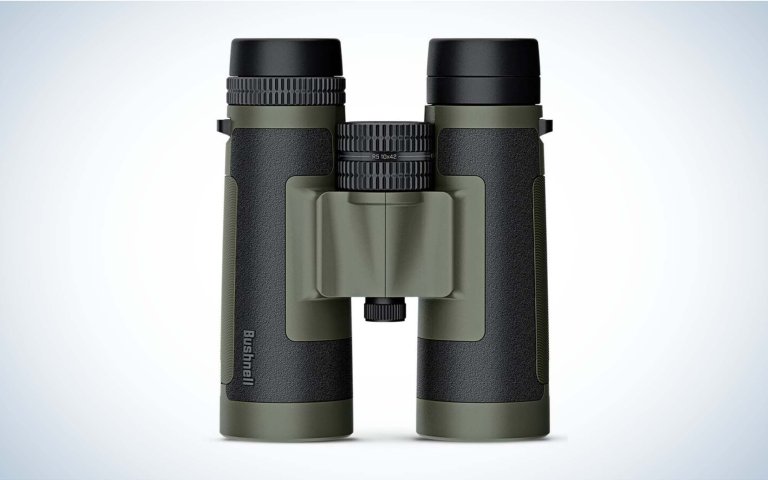
See It
Pros
- Lightweight
- Lifetime warranty
- Front-hinge ¼-20 threaded tripod adapter
- At around $150, affordable
Cons
- Abundant optical aberrations
- Focus wheel binds
Key Features
-
Right-barrel non-locking diopter -
3-position eyecups -
Handsome black-and-green styling -
Ships with Vault TMLite harness
This entry-level binocular begs the question: Is affordability worth the reduced cost of entry?
The optics test jury is out on this question. Half the team felt like this would be a decent entry-level optic for a beginning hunter or outdoors person. The other half felt like the glass and controls were so poorly rendered that they’d recommend a buyer save their money for a more expensive, but better performing binocular.
But, at a real-world street price of about $150, it’s a decent value, and with a lifetime warranty and the very good Vault TMLite bino harness that comes with the R5, it’s hard to go wrong.
We won’t dwell on the glass, which is pretty much what you’d expect. We were more disappointed with the sloppy focus wheel, which has a flat spot that tends to bind while you riff from close focus to infinity. That’s not ideal.
The one detail that is perfect is the objective lens coating. Bushnell has spent decades developing its EXO Barrier and IPX7 waterproofing coatings, and it’s an argument to buy a price-point bino from an established optics company because you get those coatings almost for free.
Note that we also had Bushnell’s R5 in 12×50 in our test, and most of our impressions of the 10×42 also apply to the larger binocular.
| Bushnell R5 10×42 Specs | |
| Magnification: | 10-power |
| Objective Lens: | 42mm |
| Light Transmission: | Not provided |
| Exit Pupil Diameter: | 4.2mm |
| Twilight Factor: | 20.5 |
| Field of View: | 330 feet at 1,000 yards |
| Close Focus: | 13 feet |
| Weight: | 23.8 ounces |
| Length: | 6.1 inches |
Leupold BX-4 Pro Guide HD Gen2 8×42
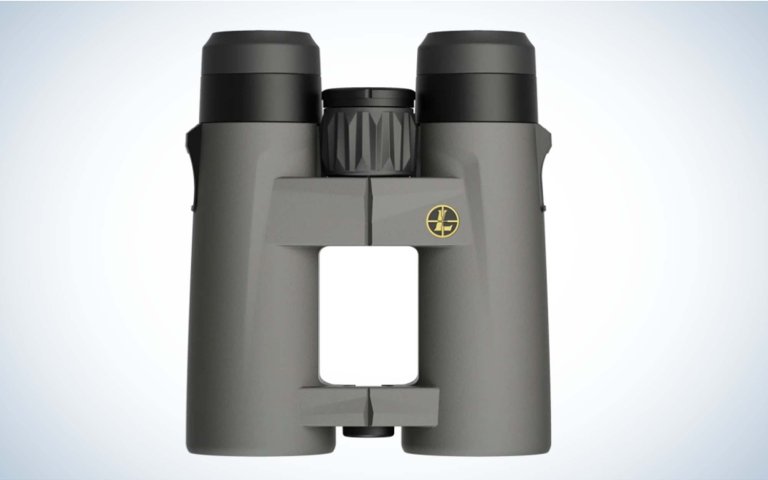
See It
Pros
- Form-Fit interchangeable eyecups
- Open-barrel design enables one-hand operation
- Good glass and coatings
- Tripod-mountable
- Handsome graphite-and-black styling
Cons
- Forgettable glass
- Blue color fringing
Key Features
-
Ships with three eyecup styles -
Center-dial lockable diopter control -
Versatile configuration -
Lifetime transferable warranty
We’ve voiced many of our impressions about the overall build and features of the BX-4 Pro Guide HD Gen2 binoculars in the 12×50 review, but it’s worth a few paragraphs about the specific results of the 8×42 version.
While it scored a few points lower in overall tabulation behind the 12×50, the difference was mainly on low-light and image scores, where the smaller objective lens diameter and magnification held it back. Its 5.25mm exit pupil, on the other hand, gives it a bright image in nearly all conditions. In terms of handling and ergonomics, the 8×42 is a darling. It is sized perfectly for one-hand operation, making it a great spot-and-stalk optic for a bowhunter.
While we swapped out each of the three eyepieces, our consensus pick was the tapered model that comes delivered on the optic out of the box.
Lastly, some testers noted blue edge aberration and a loose focus wheel. At somewhere between $599 (Leupold’s price) and $399 (the price we saw this advertised at retail), it’s priced right for a mid-sized, do-everything binocular that has excellent ergonomics.
| Leupold BX-4 Pro Guide HD Gen2 8×42 Specs | |
| Magnification: | 8-power |
| Objective Lens: | 42mm |
| Light Transmission: | Not provided |
| Exit Pupil Diameter: | 5.25mm |
| Twilight Factor: | 18.3 |
| Field of View: | 376 feet at 1,000 yards |
| Close Focus: | 10 feet |
| Weight: | 24.5 ounces |
| Length: | 5.7 inches |
Leupold BX-4 Pro Guide HD Gen2 10×50
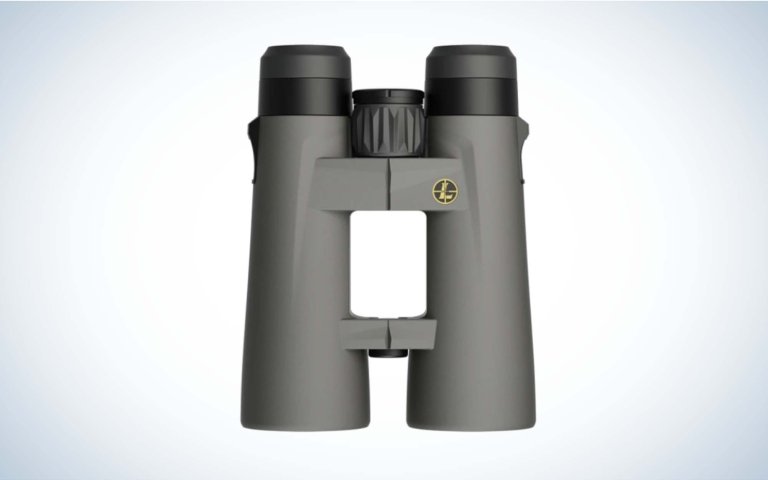
See It
Pros
- Form-Fit interchangeable eyecups
- Open-barrel design enables one-hand operation
- Good glass and coatings
- Tripod-mountable
- Textured focus wheel
Cons
- Forgettable glass
- Difficult tripod mounting receiver
Key Features
-
Ships with three eyecup styles -
Center-dial lockable diopter control -
Lifetime transferable warranty -
Versatile configuration
Like the 8×42 and 12×50 versions of the BX-4 Pro Guide HD Gen2 (that’s a mouthful), we had mixed impressions of this 10×50. It’s nicely hefty, and the 50mm objective lens gives the binocular a nice, bright 5.0mm exit pupil. The open-barrel design provides plenty of gripping surface, though we liked the balance and handling of the 8×42 a bit more than the larger 50mm.
We had the same gripes about the glass in this version that we did in the others, namely a noticeable blue flaring. Two testers reported difficulty getting a tripod mount to screw into the front-hinge receptacle, which is a few thread revolutions too shallow.
“I really want to like you but your glass is whack,” noted tester Luke Coccoli, who added that he liked the heavily textured focus wheel and locking center-dial diopter control.
Interestingly, the 10×50 version is slightly lighter than the 8×42 Leupold, and delivers an impressive field of view.
| Leupold BX-4 Pro Guide HD Gen2 10×50 Specs | |
| Magnification: | 10-power |
| Objective Lens: | 50mm |
| Light Transmission: | Not provided |
| Exit Pupil Diameter: | 5.0mm |
| Twilight Factor: | 22.4 |
| Field of View: | 299 feet at 1,000 yards |
| Close Focus: | 9.3 feet |
| Weight: | 28.7 ounces |
| Length: | 6.8 inches |
Great Binoculars from Past Tests
2024 Editor’s Choice Winner: Swarovski NL Pure 10×52
See It
Pros
- Premium field-flattener lenses
- Tapered tube design enables shake-free holding
- Premium glass and coatings
- 10-foot close focus
- Lightweight
Cons
- At $3,449, a wildly pricey binocular
- Non-locking diopter
- Tripod mount sold separately
Score Card
-
Optical Performance:
Excellent -
Mechanical Performance:
Excellent -
Design:
Excellent -
Price/Value:
Good
Key Features
-
Wasp-waist, open-barrel design -
Center-wheel diopter control -
Oversized focus wheel -
Field of View:
426 feet at 1,094 yards -
Also available in 32mm and 42mm models -
Weight:
36 ounces -
Price:
$3,449
Once you recover from the sticker shock of this Austrian-made binocular, find a way to experience the image and the design that starts to justify its price of $100 per ounce. In terms of image quality, low-light performance, and ergonomics, the NL Pure is one of the most remarkable binoculars Outdoor Life has ever tested.
Its distinctive external lines are purposeful. Swarovski introduced the roof-prism NL Pure four years ago in three configurations: 8×42, 10×42, and what seemed like a crazy magnification at the time, a 12×42. That high-power binocular works as a shake-free hand-held optic because of its balance and the balance-enhancing barrel shape.
This year the Austrian optic company is extending the line with a series of 52mm binos. The 14×52 version is in our large-frame binocular test, and requires stabilization to perform to its potential. The 10×52 is a better balance of hand-holdability, image delivery, and overall handling.
Swarovski calls the NL Pure a “wasp-waist” design, and a new optical prescription and redesigned prism allow the chassis to accommodate big objective lenses, a slender mid-section, and large eyepieces fitted with field-flattener lenses that enhance edge sharpness. The design also enables a monstrous field of view. The 10-power NL Pure has a 426-foot FOV at about 1,100 yards (the strange math is because I’ve converted from metric meters). That’s even wider than most 8-power binoculars, and far wider than any other 10-power that we’ve tested. If you’re a glasser that appreciates panoramic images and the ability to take in wide swaths of landscapes, the NL Pure is for you.
This binocular is decidedly not for you if you want to mount it to a standard tripod. One of the more frustrating aspects of Swarovski’s design is its proprietary front-hinge tripod socket. Instead of being fit with a standard ¼-20 thread, the NL Pure has a special click-lock socket that only accepts Swaro’s tripod mount, which sells for an additional $200. A cheaper alternative is to buy the $60 NL Pure adapter at Outdoorsmans and install it yourself. But either way, it’s an affront to working-class glassers to have to buy an aftermarket tripod mount after spending $3,500 on the binocular.
Testers also dinged the NL Pure for its non-locking center-dial diopter, which features a tab that can easily get bumped off plumb, especially if users employ enclosed bino harnesses. Evaluators had mixed reviews of Swaro’s proprietary harness mounting system, which features push-to-turn locking studs that hold straps to the chassis. The system, while elegant, requires users to stick with Swarovski’s hardware, and to buy expensive replacements when they inevitably lose one or both of the studs.
But these external nuisances distract from the NL Pure’s astonishing image. The binocular easily won our low-light test, thanks to premium glass and coatings and those huge 52mm objective lenses. The image delivered by the NL Pure is so vibrant, bright, and pleasing that testers gravitated to the Swarovski any time they wanted to get a better look at a distant object. That’s the best testament to a world-class optic: that users spend more time behind it. And as hunters know, the more you look with an optic, the more you’ll see, and the more successful you’ll ultimately be in the field. It’s hard to put a price on that level of performance.
2023 and 2024 Best Value Winner: Vortex Triumph HD 10×42
See It
Pros
- Ships with excellent GlassPak harness
- Light
- Extremely accessible real-world street price of under $100
Cons
- Significant peripheral distortion
- Flimsy feeling
Score Card
-
Optical Performance:
Fair -
Mechanical Performance:
Good -
Design:
Good -
Price/Value:
Very Good
Key Features
-
Single-hinge, closed-bridge design -
Roof-prism design -
Right-barrel diopter control -
Fully transferable lifetime warranty -
Tripod adaptable -
Weight:
22.9 ounces -
Price:
$99
How on earth can Vortex bring a capable binocular to the masses for under $100? With a good bino harness and the brand’s legendary warranty? Those were questions our test team batted around as we handled this entry-level binocular. Then we got behind the lenses and learned some of the answers.
The biggest answer is the class of glass inside the new Triumph HD is cheap. The Vortex received uniformly downbeat assessments in optical performance; it scored near the bottom in low-light brightness, and its resolution score was just below the median. Testers further complained about blue color fringing, noticeable edge distortion, and blurry focus.
But we also recognized that you shouldn’t expect world-beating glass inside a $99 binocular, and that same realism pervaded our assessment of the Triumph’s mechanical performance. The diopter adjustment is stickier than we’d like, and the overall build feels flimsy. But the tapered eyecups move with positivity and the focus wheel is tight and responsive. The texturing, balance, and overall design is better than we’d expect for the price.
On the value side of the ledger, the GlassPak case and integrated harness confirms the best value designation we gave the Triumph HD. This would make a very good first optic for a hunter, birder, or shooter, and if treated gently is a good choice to throw in a pickup or cabin. We’re not sure how much rough handling this bino can take, but Vortex’s excellent warranty and customer service is a cheering consolation.
Read Best Binoculars for the Money to see more high-value binoculars. Or read our full Vortex Triumph HD review to learn more.
Maven B.7 8×25
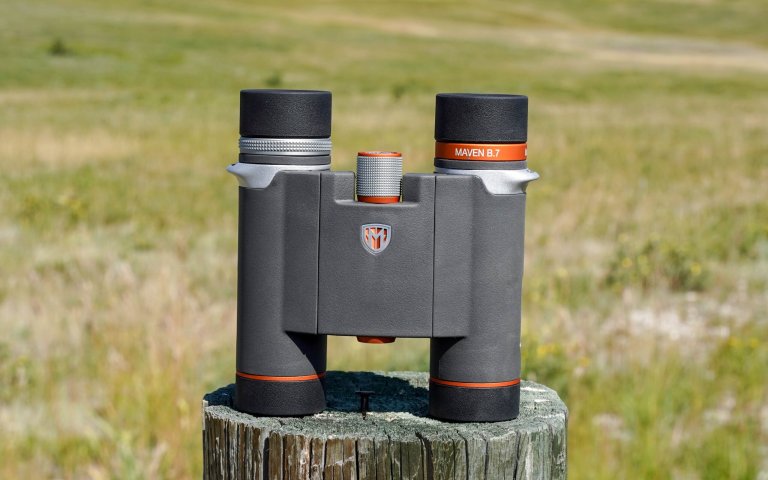
See It
Pros
- Highly textured focus and diopter controls
- Excellent treestand or turkey-vest optic
- Distinctive orange accents
Cons
- Too small for open-country glassing
- Controls hard to manipulate with gloves
Score Card
-
Optical Performance:
Good -
Mechanical Performance:
Very Good -
Design:
Very Good -
Price/Value:
Good
Key Features
-
Double-hinge, closed-bridge design -
Right-barrel diopter control -
Extra-low-dispersion glass -
Extremely compact design -
Also available in 10×24 -
Weight:
12.4 ounces
With this petite binocular, introduced earlier this year, Maven is well on its way to filling out its product line. The B.7 is a compact version of the direct-to-consumer company’s excellent B.3 line.
It should be said at the outset that this is a fairly specialized optic. It’s configured for portability and use in tight quarters and in close ranges. Think whitetail hunting out of a treestand. A travel optic when weight and space is at a premium. Turkey hunting just about anywhere. I use sub-compact binoculars when upland hunting, tucked in a pocket of my upland-bird vest, in order to positively identify distant birds, to find my dog, or confirm a distant point.
The Maven is one of the best-rendered versions of this class of diminutive binocular. The double-hinge design allows the barrels to nest under the bridge, and can fit inside a roomie shirt pocket. The glass is surprisingly good for this mini optic. Maven uses extra-low-dispersion glass that reduces glare and boosts colors and contrast of images, and helped the B.7 post one of the best resolution scores of our 2023 binocular class. But the ED glass is also responsible for the fairly steep price; the 8-power B.7 retails for $600; the 10-power version sells for $625.
Outdoor Life’s optics test team gave the binocular good price/value scores, and they praised the solid build and responsive controls. But several testers noted the limitations of the platform.
“This would be a good spot-and-stalk bino for those times when I don’t want to carry a pack or even a binocular harness,” said tester Ky Idler. Tester Dale Manning further noted that the B.7 would “make a great optic for sporting events, turkey hunting, deep-woods treestand hunting, but for me it’s too small to be a go-to field bino.”
Fair enough, but for those hunters looking for a combination of outsized optical performance in a very trim package, this binocular fits just about anywhere.
Vortex Razor UHD 8×32
See It
Pros
- Durable magnesium chassis
- Premium glass
- Easy to use with a single hand
- Oversized focus wheel
- Ships with premium GlassPack Pro harness with rangefinder pouch
Cons
- At nearly $1,500 street price, expensive for an 8×32
- Thumb indents could be larger to accommodate large hands
Score Card
-
Optical Performance:
Excellent -
Mechanical Performance:
Very Good -
Design:
Very Good -
Price/Value:
Very Good
Key Features
-
Open-hinge open-barrel design -
Right-barrel locking diopter control -
Tripod-mountable -
5.9-foot close focus -
Weight:
21.9 ounces -
Field of view:
472 feet at 1,000 yards -
Price:
$1,450
Vortex’s new flagship binocular has it all: excellent glass, nice handling, a durable build, and wonderful field of view. The compact 8×32 in our test produces a big image out of proportion to its size, and testers noted it’s a perfect bowhunting optic, since it can be capably handled with a single hand and offers excellent mid-range performance. Enhancing its handling, whether you use one hand or two, the Razor UHD features thumb indentations in the chassis that are placed at the balance point of the binocular. That added touch allows for good gripping, though one ham-handed tester wanted these depressions to be a bit larger to fit his silver-dollar-sized thumbs.
The 8×32 joins a compact 10×32, both introduced this year, to fill out Vortex’s excellent Razor UHD line, which includes 10×42, 10×50, 12×50, and 18×56 models. The literalists of our test noted that the term UHD, which stands for Ultra High-Definition glass, doesn’t have a defined meaning. It’s a marketing term to refer to a higher grade of glass and coatings than those used in Vortex’s HD (pedestrian High-Definition) optics.
Regardless of semantics, its exceptional glass and coatings allowed the 32mm Vortex to hang with big 42mm and even a 52mm binocular in our low-light test. Other accolades for the Razor UHD include a locking diopter, fast-focus wheel, and thin eyecups that fit most brows. Perhaps recognizing that $1,500 is a lot to spend on a binocular, Vortex adds its very good GlassPak Pro harness and rangefinder pouch to the deal. Those accessories retail for around $150.
We did note a surprising aberration. Testers recorded noticeable flaring when they peered toward the sun, an optical anomaly that may be caused by dust on an interior lens. We didn’t expect to see that in an optic at this price point.
But most users are unlikely to notice that demerit, one of the very few in an otherwise capable, fine-handling, and extremely bright binocular. Given Vortex’s fully transferable lifetime warranty and exceptional customer service, any deficiencies that users note are bound to be covered by the company.
The Test Protocol

We put all submissions to our annual binocular test through the same criteria. First, we measure optical resolution, using the diminishing black-and-white lines of a 1951 Air Force Resolution Target to score the optical performance of each submission. We also measure the low-light performance of each binocular by mounting them to tripods and focusing them as a group at 200 yards at a black-and-white resolution target starting at twilight and then well into the gathering dark, all in order to measure the brightness of the glass. This is an important consideration for both hunters and wildlife watchers, since animals are more visible in the early morning and late evening than at any other time.
The binocular that can “see” the longest into the dark gets top marks. The model that loses its night vision earliest gets the lowest score. Binoculars in the middle receive weighted scores somewhere between those two poles. We averaged the results over at least three nights, with a different pair of eyeballs behind the binoculars each night, to arrive at our adjusted score.
How We Scored the Results
We break our 10-point scoring into four general categories: optical performance, mechanical performance, design, and value. The average of these categories is the basis of our grades, detailed below.
Optical performance includes the resolution and low-light tests plus the more subjective assessments of image quality and brightness. Mechanical performance assesses the durability of the submission along with its controls: focus and diopter controls, eyecup extension, and comfort. In the case of rangefinding binoculars, it also factors the electronic interface and performance. Design considers the exterior finish, interior blacking, tripod mount, and its innovation and versatility, along with its comfort. We ask testers to evaluate this critical question: how long could you glass with this binocular?
And then our price/value score rates how much optic—along with warranty and amenities such as carrying case or harness—you get for your money. The binocular that gets the highest overall score wins our Editor’s Choice award for the best in the category; the optic with the highest price/value score wins our Great Buy recognition.
Our 10-point evaluation adds up to a total numeric score, but we translate those to grades for each submission. The optical performance grade combines the scores from resolution, low light, image, and brightness. Our mechanical performance grade aggregates the mechanics and durability score. The design grade considers construction, innovation, versatility, and comfort. And then the price/value grade is our value grade.
To earn an “Excellent” grade, the average of that category must be 9 or higher, which is extremely hard to achieve. “Very Good” is an average score of 7 to 9. A “Good” grade is 5 to 7. Our “Fair” grade is 3 to 5, and “Poor” is anything under 3.
Read the full article here











